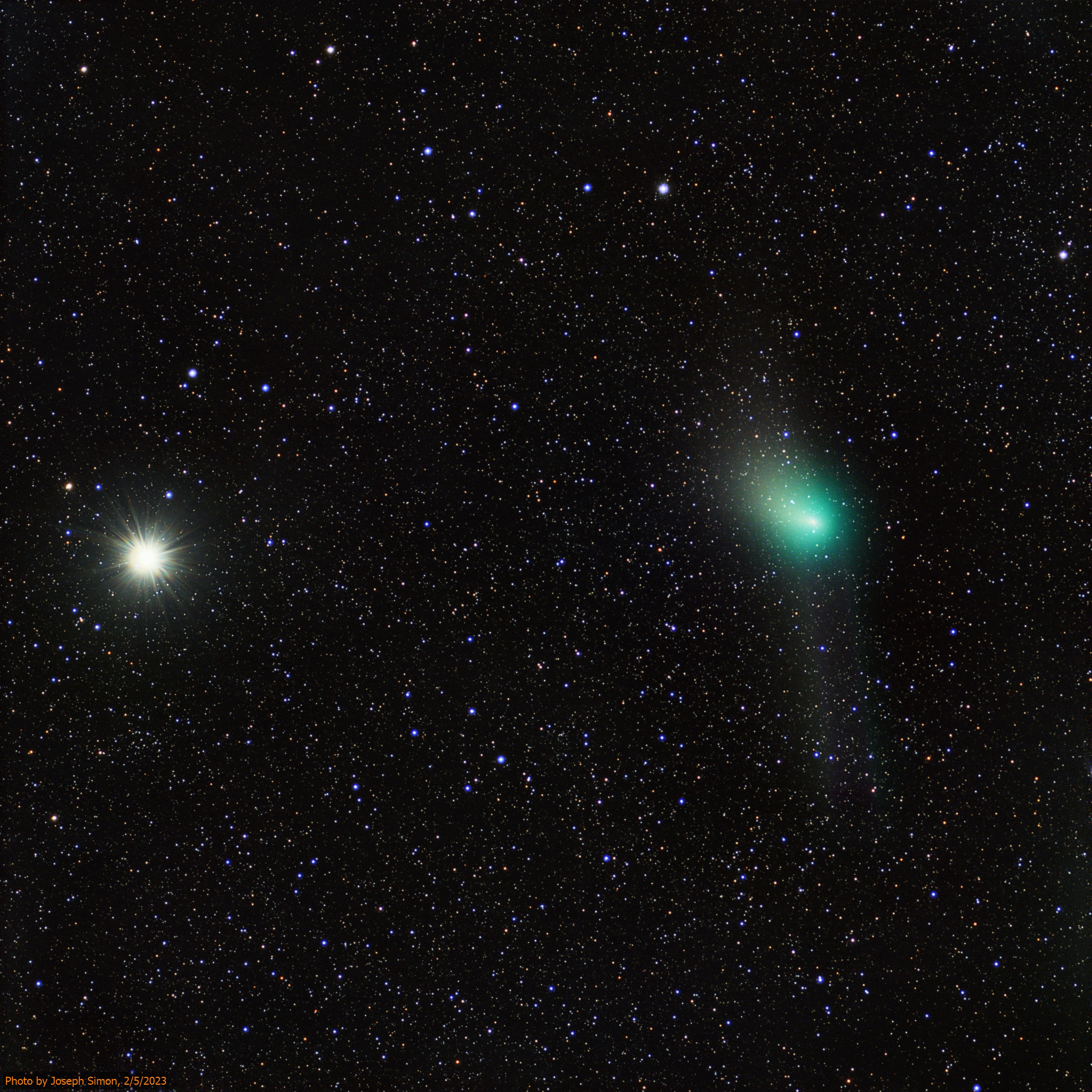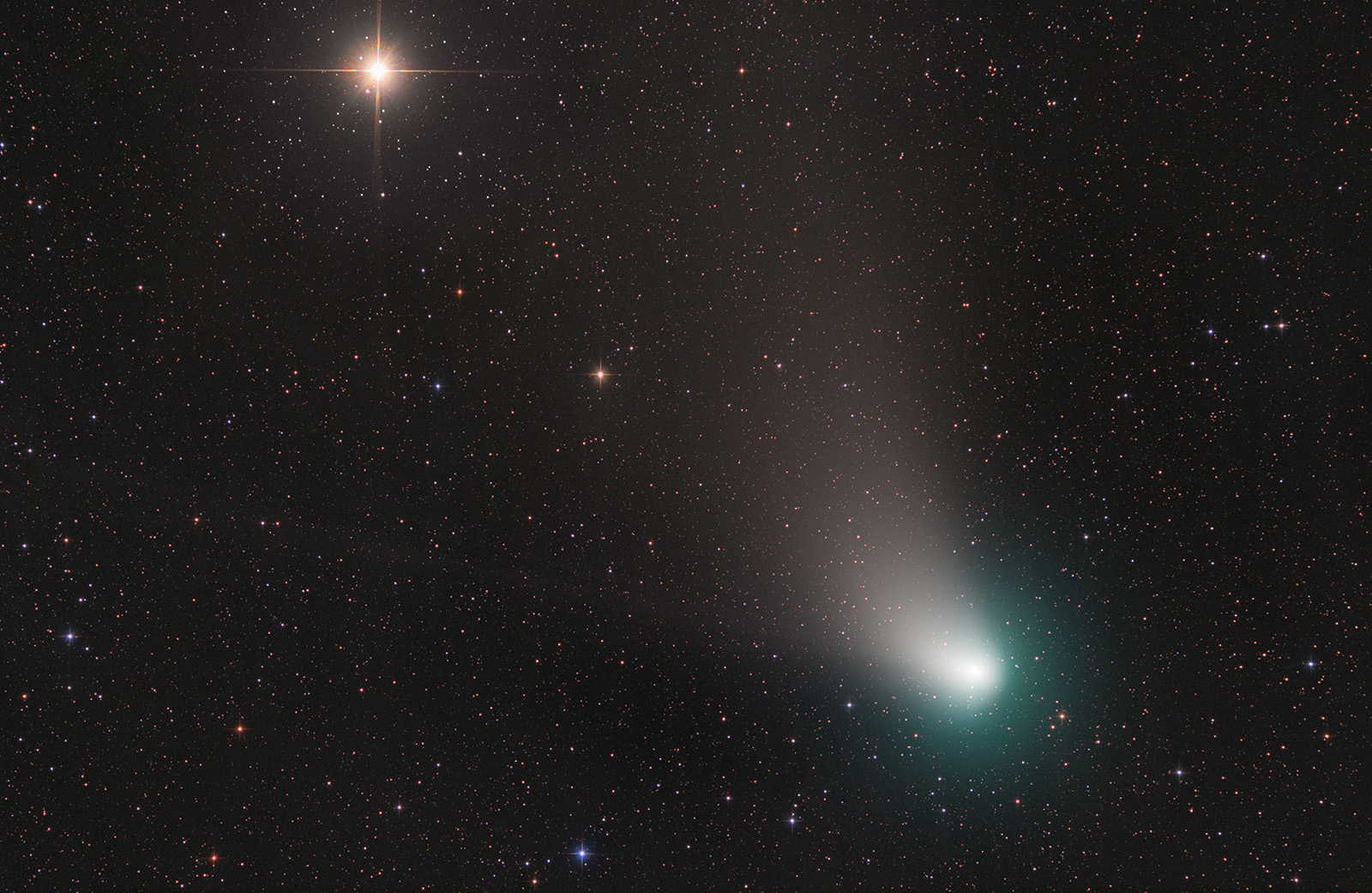Green comet C/2022 E3 (ZTF) may be heading out of the solar system for good
The comet C/2022 E3 (ZTF) may be back around Earth in 50,000 years — if it isn't racing out of the solar system that is.

The comet C/2022 E3 (ZTF) became quite the celestial celebrity in early 2023 as its close approaches to the sun and then Earth made its bright green glow visible from our planet, but this might be its last visit.
According to NASA's Jet Propulsion Laboratory (NASA JPL) the comet is on a 50,000-year orbit of the sun, or at least it was. The close approach of C/2022 E3 (ZTF) to the inner solar system might have altered its orbit enough to ensure it is now on a one-way trip out of the solar system.
"When a solar system object is 'weakly hyperbolic' — that is, it has just enough speed that it would, after thousands of years, escape from the gravity of the Ssn [solar system] entirely — then even small changes in speed can change the orbit dramatically," Adler Planetarium scientist Geza Gyuk said in a statement. "If an object is 'weakly bound' — that is, the orbit is a closed ellipse, but very large — then it can be unbound and turn into a 'weakly hyperbolic' orbit very easily."
Related: Watch green comet near Mars Saturday with free telescope livestream
Read more: How to view and photograph comets

Looking for a telescope to see comet C/2022 E3 ZTF? We recommend the Celestron Astro Fi 102 as the top pick in our best beginner's telescope guide.
For comets with orbits like this, resembling an extremely flattened circle, that go way beyond the solar system's planets it is easy for their orbits to be perturbed. This could have the effect of causing them to fly out of the solar system altogether. That means each time that a comet with an orbit like this dives back towards to inner solar system to visit Earth and the sun, that close approach could be its last.
And according to Adler Planetarium, that could be the case with C/2022 E3 (ZTF). On the inbound stretch of its latest orbit, the comet was on a closed elliptical orbit with a period of 50,000 years. On this inward leg the gravity of one of the planets it passed, probably Jupiter, altered the orbit C/2022 E3 (ZTF).
As a result of this nudge, the outward leg of this journey, which C/2022 E3 (ZTF) is currently undergoing, might not just see it racing out of the inner solar system, it might carry it out of our planetary system altogether.
Get the Space.com Newsletter
Breaking space news, the latest updates on rocket launches, skywatching events and more!
That means C/2022 E3 (ZTF) which last passed Earth 50,000 years ago during the last glacial period or "ice age" when early homo sapiens shared the planet with the Neanderthals, might never return.
Alternatively, this planetary perturbation might have put the comet on an even more extended and flattened orbit that lasts for a million years or more.
C/2022 E3 (ZTF) might have moved out of view forever or you may not fancy waiting around a million years for it to pop back around, but if you're hoping to catch a glimpse of the next comet to make headlines, our guides for the best telescopes and best binoculars are a great place to start.
And if you're looking to snap a few photos of the comet, be sure to see our guides on how to photograph comets, as well as our best cameras for astrophotography and best lenses for astrophotography.
Read more: Bright green comet a rare 'messenger from the outer reaches of our solar system,' astronomers say

C/2022 E3 (ZTF) was initially discovered in March 2022 by the wide-field survey camera at the Zwicky Transient Facility while it was traveling inside the orbit of Jupiter. Initially, suspecting it to be an asteroid astronomers realized C/2022 E3 (ZTF) was a comet when it began to brighten as it approached the sun.
This brightening happens to comets as they approach the sun and are heated by solar radiation. This causes material at their surface to transform from solid ice to gas in a process called sublimation.
The released material surrounds the comet's main body forming what is known as its "coma" and also the bright characteristic tail of a comet. This indicated that as C/2022 E3 (ZTF) approached Earth it could brighten enough to be visible with the naked eye.
C/2022 E3 (ZTF) made its close approach to the sun, its "perihelion," on Jan. 12 when it passed to within 100 million miles (160 million kilometers) of our star. It then headed to Earth, making a close approach to our planet, its "perigee," on Feb. 1. During the perigee it was just around 26 million miles (42 million kilometers) from Earth, equivalent to about 28% of the distance between Earth and the sun.
Time will tell if this was the final perihelion and perigee of C/2022 E3 (ZTF).
Editor's Note: If you get a photograph of C/2022 E3 (ZTF) during its visit to the inner solar system and would like to share it with Space.com's readers, send your photo(s), comments, and your name and location to spacephotos@space.com.
Follow us @Spacedotcom, or on Facebook and Instagram.
Join our Space Forums to keep talking space on the latest missions, night sky and more! And if you have a news tip, correction or comment, let us know at: community@space.com.

Robert Lea is a science journalist in the U.K. whose articles have been published in Physics World, New Scientist, Astronomy Magazine, All About Space, Newsweek and ZME Science. He also writes about science communication for Elsevier and the European Journal of Physics. Rob holds a bachelor of science degree in physics and astronomy from the U.K.’s Open University. Follow him on Twitter @sciencef1rst.
-
rod "According to NASA's Jet Propulsion Laboratory (NASA JPL) the comet is on a 50,000-year orbit of the sun, or at least it was. The close approach of C/2022 E3 (ZTF) to the inner solar system might have altered its orbit enough to ensure it is now on a one-way trip out of the solar system. "When a solar system object is 'weakly hyperbolic' — that is, it has just enough speed that it would, after thousands of years, escape from the gravity of the Ssn entirely — then even small changes in speed can change the orbit dramatically," Adler Planetarium scientist Geza Gyuk said in a statement(opens in new tab). "If an object is 'weakly bound' — that is, the orbit is a closed ellipse, but very large — then it can be unbound and turn into a 'weakly hyperbolic' orbit very easily."Reply
Interesting, the eccentricity report is > 1.0 for some of the reports, earlier less than 1.0.
https://minorplanetcenter.net/mpec/K22/K22F13.html
Orbital elements:
C/2022 E3 (ZTF)
Epoch 2023 Jan. 16.0 TT = JDT 2459960.5
T 2023 Jan. 13.18676 TT Rudenko
q 1.1142870 (2000.0) P Q
z +0.0000075 Peri. 145.77014 -0.59957589 -0.07436053
+/-0.0017500 Node 302.51706 +0.33745805 +0.87934395
e 0.9999916 Incl. 109.09060 +0.72569333 -0.47034533
From 62 observations 2022 Mar. 2-21, mean residual 0".3.
C/2022 E3 (ZTF)
Epoch 2022 Jan. 21.0 TT = JDT 2459600.5
T 2023 Jan. 13.22509 TT Rudenko
q 1.1145097 (2000.0) P Q
z +0.0001782 Peri. 145.77000 -0.59961021 -0.07432640
+/-0.0017500 Node 302.51764 +0.33743842 +0.87936168
e 0.9998014 Incl. 109.09424 +0.72567410 -0.47031758
From 62 observations 2022 Mar. 2-21, mean residual 0".3.
e > 1.0 here:
C/2022 E3 (ZTF)
Epoch 2023 Feb. 25.0 TT = JDT 2460000.5
T 2023 Jan. 12.78377 TT Rudenko
q 1.1122258 (2000.0) P Q
z -0.0002948 Peri. 145.81613 -0.60063693 -0.07340165
+/-0.0000006 Node 302.55513 +0.33754320 +0.87940287
e 1.0003278 Incl. 109.16793 +0.72477574 -0.47038578
From 4964 observations 2021 July 10-2023 Jan. 6, mean residual 0".5.
Some values could suggest a closed orbit, knowing with certainty seems more like a comet story linking to the long ago, past :) I have observed this comet 12x now since 24-Dec-2022, Corona Borealis around Ursa Minor, near Mars, and perhaps again tonight where it will be some 2.5-degrees or so from Aldebaran about 2000 EST for my location. Interesting to use 10x50 binoculars and 90-mm refractor telescope, observe and record the comet observations in my home database (MS ACCESS). Others reported how difficult the comet was to track down and see (some did not see this comet), theskylive.com reports 6.4 magnitude now for the comet. -
rod I did view this comet again tonight. Observed 1800-2000 EST. Last Quarter Moon 13-Feb-2023 1601 UT. I enjoyed some very good views of C/2022 E3 (ZTF) this evening using the XT10i with TeleVue 35-mm PO. 34x and true FOV about 1.8-degrees. The XT10i presented a brighter image and easier to see than my 90-mm refractor telescope views. The comet was a bit more than 2.5-degrees from Aldebaran and about 56 arcminutes from the open cluster NGC 1647 in Taurus (Stellarium 1.2). Bright nucleus and larger comma, a tint of green or blue green in the nucleus area. The open cluster NGC 1647 and C/2022 E3 (ZTF), I could see both in the FOV, this was an enjoyable sight and could make for a good photo. Theskylive.com reported magnitude 6.3 magnitude for C/2022 E3 (ZTF) this evening. Stellarium 1.2 shows NGC 1647 open cluster 6.4. I did enjoy some views of M45 in Taurus as well, excellent. Clear skies, temperature 6C, winds 270/6 knots. Some polar orbiting satellites passed by the FOV near the comet tonight while I viewed. Using the 9x50 finder scope, I could see C/2022 E3 (ZTF) as a distinct fuzzy in the finder. The Telrad made for easy targeting and locating, placing the comet in the eyepiece FOV.Reply









